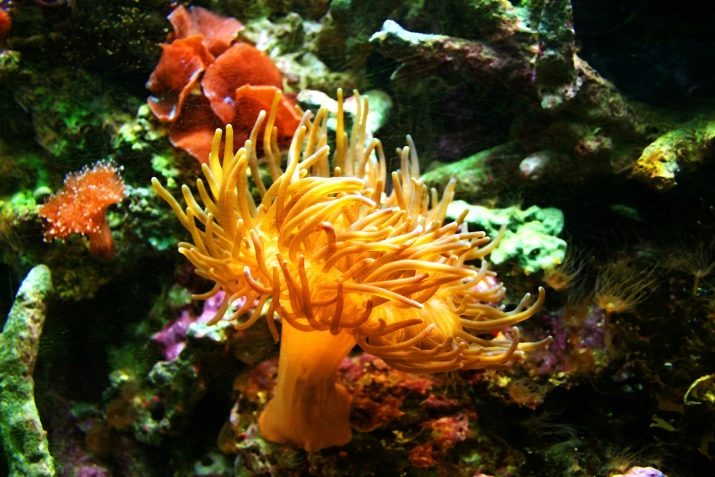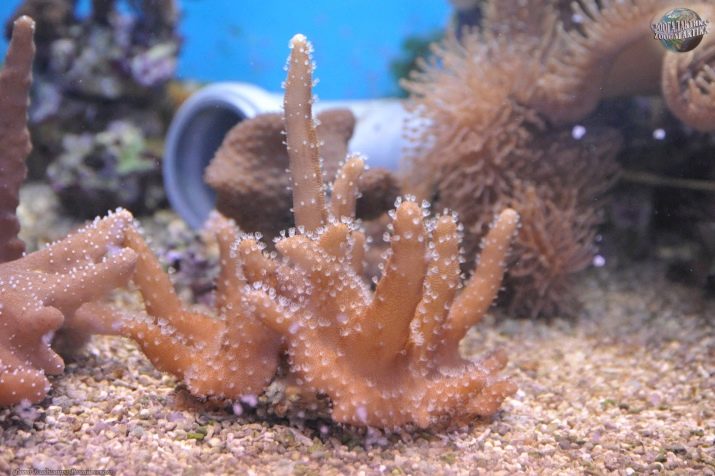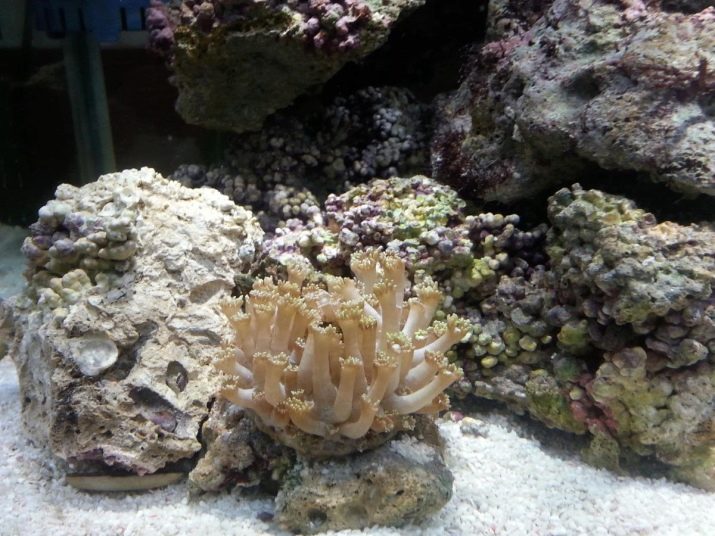Underwater corals often amaze people with their beauty. Moreover, such organisms perform not just a decorative function. They can be called living creatures that require special nutrition, as well as care. With their help, it is quite possible to recreate the natural conditions in the aquarium.



Living species
All corals for an aquarium are divided into 2 categories: soft and hard.
Most often they live in colonies, however, solitary species are also found.
Some of them have a calcareous skeleton, besides they are called solid. They live on the seabed. Others consist of a soft base and live near reefs. Among them, it is worth noting those that do not require special care.


Sea anemones
This coral family is completely devoid of skeleton. They are attached to the ground with the help of special suction cups, which are called the "sole". They feed on small fish or small clams. Sea anemones paralyze their victim with strong poison, and then pull it up with their tentacles.

Lobophytum
This variety is especially toxic, so you should carefully select it for your aquarium. After all, she can easily poison living corals nearby.
therefore they should be planted as far apart as possible. For this living organism to feel comfortable, it needs a lot of light. It is necessary to feed the lobophytum with the help of symbiotic algae or plankton.

Acropora
It requires stability, as well as good lighting, and also very poorly tolerates any changes in temperature conditions. To keep the acropore in good shape, calcium or strontium must be added to the water.You can feed any algae, as well as plankton.

Marine coral mushrooms
They belong to the Actinodiscus family and remain a mystery to many biologists. Organisms do not tolerate too bright light.
They reproduce best when fluorescent lights are turned on next to the aquarium, and the water flow is not too strong.
They can live with fish, as well as with active invertebrates. Feeding with the help of the mucous mesh. Mushrooms simply capture particles of substances that float around them.

Leathery
They belong to the family Cladiella and are a pretty beautiful variety of corals. In the natural environment, such corals are not too deep, so in the aquarium they will feel perfect under normal lighting, as well as the smallest flow of water. Like mushrooms, leathery corals can live with fish, crayfish, or various invertebrates.

Star
This type of coral is completely unpretentious in content. They can exist well in good lighting, and with its lack.
In addition, such polyps are quite sensitive to iodine, which means that you should not install sponge filters too close to them.
Also, corals can prevent the appearance of mucus on stones, as well as on gravel. Organisms can be painted in different colors, from purple to violet-red. But among them you can find a dark and bright green hue.

Zoontaria
They belong to the family Protopalythoa. Propagate very intensively in good light. They eat almost any food that comes in their way. The color is brown, they can produce palitoxin, which has a bad effect on the nervous system of people. As a result, a person can simply die.

Grebe mushrooms
In another way, such mushrooms are called sacrophyton. They divide quickly even in the worst of conditions.
They can adapt to any conditions, for this reason they are very popular among many aquarium lovers.
Sacrophyton feeds, absorbing various organic components from water. They are painted in cream or brown colors.

Golovachi
Their reproduction occurs best when the lighting is quite bright. Their activity begins with the onset of night. Although by nature such corals are peace-loving, still in some cases poisonous tentacles may begin to form in them.

Madreporic
Such corals differ in that they can live both in colonies and in solitude. They will feel great both in bright light and in the shade. But the water in any case should be transparent and clean. They can eat small pieces of meat, such as shrimp or fish.

Pros and Cons of Artificial Products
As for artificial corals, this is the easiest option for decorating an aquarium. Most often they are made of silicone, so they are easy to clean and look like real ones. Artificial corals have many advantages. This is both high environmental friendliness and practicality. Besides they are durable, which means you don’t have to constantly buy them again. As for their color, it is quite diverse.
To make this underwater decor look as natural as possible, care must be taken to make the corals look like real ones. However, along with this, artificial corals also have disadvantages.

First of all, it is their high price. In addition, if low-quality materials are used for their manufacture, then the products will be toxic. So, the rest of the aquarium inhabitants will suffer, first of all.
How to choose?
Before buying corals, you need to take care of creating an ecological balance. Besides, you need to buy them in special stores, in addition, complete with small particles of substrate. Such a purchase will help increase coral viability in the future.
If it is torn off from the usual substrate, then in the new environment it may not take root.
Be sure to buy corals that can coexist together. In addition, it is necessary to take into account where the aquarium itself will be located. After all, the choice of coral should depend on what the lighting will be.

Content Recommendations
To maintain coral, you must purchase an aquarium with a volume of at least 400 liters. Water in it should be in the range of 22-27 degrees. This will allow living corals to absorb from it all the substances necessary for the growth of the skeleton. In addition, the water must be clean and of high quality. It is important to ensure that it can circulate constantly.
Lighting in the aquarium should be suitable for a certain type of coral. Everything must coexist in balance, otherwise the organisms will simply die. After the purchase, the coral should be placed on a stone, on which it will continue to grow. You can attach it with a special glue. Besides, do not throw away dead corals, because they can still become part of the aquarium.

They will subsequently be able to produce bacteria that will help create conditions close to the present.
Another important issue is the nutrition of selected corals. There are 2 options, one of which occurs as a result of photosynthesis in symbiotic algae. In the second case, nutrition occurs as a result of obtaining nutrients from water.
Besides, Be sure to pay attention to when polyps appear in corals. This means it's time to feed them. The size of the food depends on the type of coral. Since they have no eyes, they eat everything that can be found nearby. As food, you can use various larvae, crustaceans, or special dry food, which can be bought at any specialized store.

Design options
It’s quite difficult to make aquarium decoration with your own hands, especially if the owner of such a “marine nursery” is a beginner, but still it is possible. Today in stores you can buy many different elements for the design of the aquarium.
Among them there are snags of various shapes, and artificial stones or grottoes that will make up the company of the selected corals.
With their help, you can make real masterpieces that will delight others with their appearance.

Tale of Coral
To realize such a fairy tale, you need to work hard. Primarily, In the background of the aquarium you need to make the desired background.
To do this, you can use either paint or a special adhesive tape of the desired color.
Then the bottom of the aquarium should be covered with a ball of small pebbles or shells, as well as small stones on which you can put purchased corals. In addition, algae can be used as green spaces.

Pseudo-marine
To create such an aquarium you will need not only corals, but also a substrate, which includes marble chips, coarse sand, granular white quartz. As decorative elements, large shells, stones and completely petrified corals can be placed at the bottom.
When all the elements are completely decomposed, you can place purchased corals, creating a real sea kingdom. In this embodiment, it is realistic to use both living corals and artificial ones. As you can see, there are a large number of corals from which you can create various sea landscapes in aquariums. If all the rules for caring for organisms are observed, then they will become a wonderful element of decor in any aquarium.

About corals in a home aquarium, see below.










